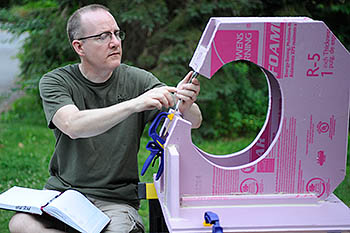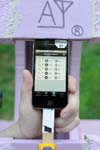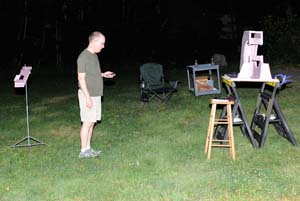iPhone 4 Meets The GripOfDeathInator
"dude, where's the blogs? are you on vacation?" -David O.
The email, tweets and calls I have been receiving have been voluminous. Both from the extremely positive responses to the previous posts, and those folks anxiously awaiting results of the more detailed tests that we promised. I should say up front that I wish we could have spent more time on these tests, but the reality is that it takes WAY more time to make careful measurements than we care to admit, and more than anyone really believes (including Consumer Reports, apparently). Alas, we will finally report on our foray into quantifying the quagmire.
First a couple of items of administrivia. I read every email I receive. I generally have not responded individually due to lack of time and the demands of my business. However, I am planning on my next blog entry to be the first in a series of "Mailbag Editions", where I will try to answer the answerable emails. You, Dear Reader, are the best source of ideas for this blog and I truly appreciate your input and insight. If you email me, I may use quotes from your email, but I won't use your personal information. If you send me a "mention" on Twitter, however, I may quote it verbatim since you already broadcast it to the world. Please use email to contact me in lieu of a phone call. I actually had someone call me today to ask me if he should buy an iPhone 4. If you are a member of the press, or a blogger, or a podcaster, I promise to do my best to get back to you and answer your questions; but, check this space first for my thoughts and information.

Steve Golson, the lab notebook and the GripOfDeathInator
On to our testing of the iPhone 4. In order to do this right, I needed some help, and not just any help. I needed another nerd engineer. Steve Golson was that unwitting volunteer. I'm implying that he didn't know what he was getting himself into, but seeing as he and I have been friends for about a third of a century, I'm guessing he knew precisely what he was in for. And he got it. In spades.
A bit about Steve. An accomplished VLSI design engineer and consultant, he was the manager of the MIT Rifle Team when I was the manager of the MIT Pistol Team back in the 80's when fast microprocessors had 1MHz clocks and antennas were obvious. Steve and his wife Terry created Hencam.com, and Terry is a wonderful chef and author. Terry released Steve for the day (and night) to accomplish this bit of engineering hacking, and for that I thank her. Without Steve, the GripOfDeathInator would not have been born.
We needed a way to hold an iPhone 4 (or any hand-held device, for that matter) in a way that did not introduce any significant conductive surfaces into its environment, and at the same time allowed a human hand to grip it in a repeatable way. We chose to work in an "open field" environment, with real cell signals. The absolute position of the device under test had be constant, so the relationship of the phone to the cellsite remained uniform. These requirements gave birth to the GripOfDeathInator, pictured above. And that is Steve beginning testing.
The GripOfDeathInator is built from one-inch thick foam sheet. It's glued together with a foam-friendly adhesive from Liquid Nails; thanks to the smart Home Depot guy for that one. The foam is pretty much RF-invisible, but it is strong enough to securely clamp our test devices. I'd love to tell you all the details of the extensive mechanical engineering that went into the design, but really, we winged it. It works as good as it looks. We also found all-plastic saw-horses to create our work table, and a wooden stool for our bag of salty water...um... Steve.
Once we had a way to repeatably position and grip the iPhone, we needed a way to measure the effect of the different grips. The "bars" are useless; we were stunned to find out that we have no idea what they mean, nor what their time constant was. Truly stunned. So, we decided to use the 3G data download and upload speeds. These measurements were made by using the Speedtest.net app. We had very fine-grained measurements of data rate, and indirectly these were telling us about the bit error rate (BER). The BER in turn tells us about the signal-to-noise ratio in the receiver, and the phone's transmitter power received at the cell site; both of these are affected by antenna performance. After much consideration, we decided this was the best way to accomplish the measurement without ripping an iPhone 4 open and firing up the soldering iron... and the microscope. As a result of separately measuring upload and download rates, we discovered that there was a couple of surprises waiting for us as you will see. Each measurement we report was the average of at least five consecutive runs; we also report the spread of those runs to show some indication of the measurement quality.
We also experimented with the azimuthal position of the phone: which direction it was facing. After making a bunch of test runs we decided it was not a significant improvement to include all the points of the compass. However, had we not explored that, we would not have discovered another interesting aspect of our measurement procedure: data rate throttling. You see, Steve was very smart in suggesting that as we tested at the four points of the compass, we rotate the apparatus back to the original position and do a fifth run. This would verify the consistency of our measurements. It was during one of these repeat runs that we observed a drop in the data rate of the download by a factor of 3-4. It lasted about 15 minutes, and things returned to normal. Additional details of this behavior will be the subject of a future blog entry. Has anyone else observed this behavior?

The VIP

The Half-GripWe developed four grip conditions: None, The Vulcan iPhone Pinch (VIP), The Half-Grip, and The Full-Grip. When the phone was not gripped, the operator (Steve) stayed in position and rested the gripping hand on the lower "C" cut in the foam. This insured that the local environment around the phone remained the same. We also kept any metal about 20 feet away or more, and kept it constant through the data runs.
As we were testing, the VIP appeared to be about the same as no grip at all. But, after crunching the data we were surprised to learn that it seemed to have a slight benefit. This could be explained several ways, and was less shocking than it was amusing.
The Half-Grip and the Full-Grip had negative impacts on the data rate that were sensible: the Half-Grip was bad and the Full-Grip was worse.

The Full-Grip

Overview of our test range showing the control phone to the left
After the data-throttling observation, we decided to set up a control phone to observe the network performance as a whole. We reasoned that should the network slow down (as had been observed) we could normalize the data using the control unit's rate measurement. We were wrong. The data throttling was IP address specific. When we had the control phone set up, we observed normal data rates on it when the other phone dropped by 3-4X. Fortunately, the drop in data rate during those periods was so precipitous, that we were able to remove any affected data points easily. More on that in a future post.
Before we get into the data, I should discuss one major limitation of our technique. We could not control the signal strength of the cell tower. We had to take what we got. The good news is that is was a "moderately good" signal; we did not have a cell tower looming over us. Nor did we have a very weak signal that would be easy to completely obliterate. We were illuminated by one cell site only, eliminating the possibility of switching between sites.
This limitation meant that once we observed a condition with good performance, it was hard to differentiate it from another condition with good performance; in other words, the data rates hit their upper limits. We could have used RF absorber material, or moved locations to reduce the signal level, but we really do have wives and kids and like to see them every now and then.
In graphical form, here are our results, below. We are reporting the average (the little box), and the spread (the little "T" bars) of the data rate measurements for both download (red) and upload (blue). Note that the vertical scale is logarithmic, which means that a change in height of the data represents a constant factor (or percentage) regardless of where it is on the graph. The shape of the "curves" is the most important thing to observe since the absolute data rates may still be broadly dependent on network loads.

We can make several interesting observations.
1) Gripping the Naked iPhone 4 certainly had a strong negative effect on the data rates, both upload and download.
2) The effect of the grips on the iPhone 3G is much smaller. But, the Full-Grip still reduces the data rate on upload.
3) Use of the Apple "Bumpers" has a very positive effect on performance. It mitigates much of the effect of the grips at our signal strength level.
4) The iPhone 4 data rates still beat the iPhone 3G data rates under all grip conditions.
5) There was a large spread in the data during the Full-Grip, in both upload and download. This highlights the sensitivity of the antenna design to direct contact by the hand.
In plain terms, the iPhone 4 SmartModule becomes a SmartPhone with the Bumpers.
What about the Consumer Reports "Duct Tape" fix? Yep, it will help. Any insulator over the "gap" area of the antenna is going to help in direct proportion to its thickness. I think Consumer Reports was going for style points in the selection of Duct Tape. Nice move - they sure dominated the news cycle.
But, hey, Consumer Reports guys: you don't do radiated tests in a shield room. That's like measuring the light output of a desk lamp in a house of mirrors. It's amateur hour. Either you didn't really explain your experimental technique fully in your video and text on your website, or perhaps you did and it really stinks. In either case, we end up agreeing with each other, so let's not dwell on that too much.
I have had the Apple Bumpers on my iPhone 4 now for about a week, and have been putting it through its paces. It does fine. I will probably get an Otter Box case when they come out (provided there are no gotchas). I cannot imagine owning this phone with no case. And I can't imagine not owning an iPhone; it's a great device.
However.... Apple: you really need to give every iPhone 4 owner a free bumper. We've proven it really helps reduce the hand sensitivity problem. And it became a problem the minute one of your employees said to a user, "You're holding it wrong." Instantly, you established that there was a right way and a wrong way to hold it. Surely, if we review our manual for the iPhone 4 we'll discover that .... oh wait .... there is no manual. And the pamphlet that comes with it says absolutely NOTHING about how to hold it. Despite its ironic title: "Finger Tips".
Apple, give everyone a bumper. And give me my twenty nine bucks back for the one I bought.
Or, just buy me sushi and we'll call it even.
